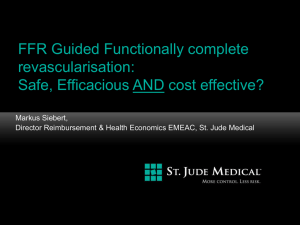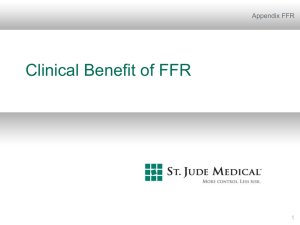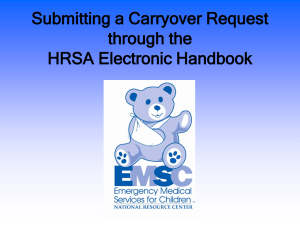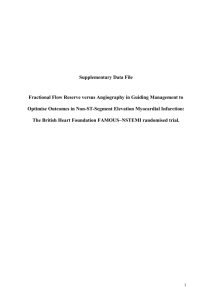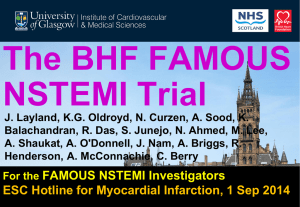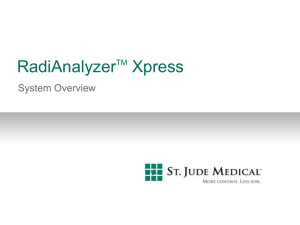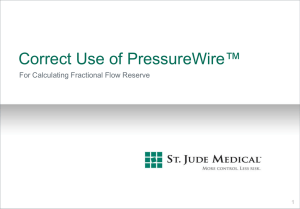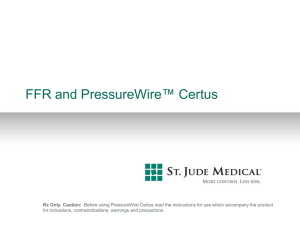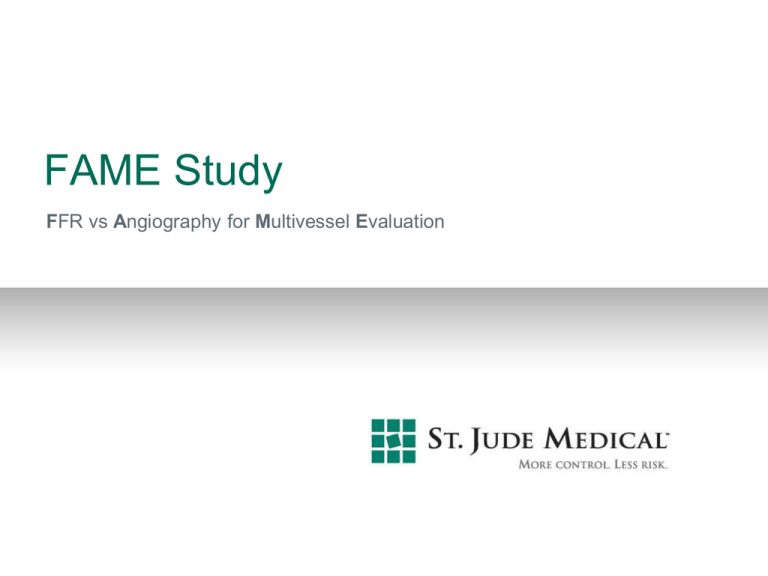
FAME Study
FFR vs Angiography for Multivessel Evaluation
Does measuring FFR really make a difference?
FAME is a large, randomized, controlled, multicenter trial
comparing stent treatment guided by FFR versus
angiographic guidance alone
The FAME study was designed to reflect the daily practice
of performing PCI in patients with multivessel disease
2
Study Design
3
Key Inclusion and Exclusion criteria
Inclusion criteria:
- Patients with multivessel disease
- At least 2 stenoses greater than or equal to 50% in 2 or 3 major
epicardial coronary artery vessels, amenable to stenting
Exclusion criteria:
- Left main disease or previous bypass surgery
- ST-elevation MI with CK greater then 1000 U/l within last 5 days
- Extremely tortuous or calcified coronary arteries
Note: patients with previous PCI were not excluded
4
Endpoints
Primary Endpoint
Composite of death, myocardial infarction, or repeat revascularization
(“MACE”) at 1-year
Secondary Endpoints
- individual components of MACE at 1-year
- functional class
- use of anti-anginal drugs
- health-related quality of life (EuroQOL-5D)
- procedure time
- amount of contrast agent used during procedure
- cost of the procedure
5
Participating Sites
Fourteen European centers and six United States centers
enrolled more than 1,000 patients in the FAME Study
6
Study Enrollment and Randomization
Assessed for eligibility
N=1905
Randomized
N=1005
7
Were not eligible N=900
Left main stenosis N=157
Extreme coronary tortuosity or
calcification N=217
Did not provide informed
consent N=86
Participation in other study N=94
Logistic reason N=210
Other reason N=31
Angiography guided PCI
N=496
FFR guided PCI
N=509
Lost to follow-up
N=11
Lost to follow-up
N=8
Analyzed
N=496
Analyzed
N=509
Baseline Characteristics
Similar characteristics in
the two groups
8
Baseline Characteristics (cont’d)
9
Results
Significant difference
between the two
groups
10
Endpoints
11
Results One-year Follow-up
FAME:
- proof that measuring FFR
during the stenting procedure
really does make a difference...
12
Results One-year Follow-up
...there is a reduction in MACE: 28%
less risk of dying, having a heart attack or having to
come back for more stents or a bypass operation
...there is a reduction in death or MI: 34%
less risk of dying or having a heart attack
Summary:
Better outcomes... AND it significantly SAVES on costs
AND it doesn’t prolong the procedure.
13
Sub-analysis – Angiographic vs Functional Severity
65%
20%
35 %
Tonino P. A. L et al; J. Am. Coll. Cardiol. 2010;55;2816-2821
14
4%
Results 2-year Follow-up
Significant difference in MI and MI/death between the two groups
Tonino P. A. L et al; J. Am. Coll. Cardiol. 2010;55;2816-2821
15
2-year Survival from Death and MI
Tonino P. A. L et al; J. Am. Coll. Cardiol. 2010;55;2816-2821
16
Results Two-year Follow-up
Significant difference in MI and MI/death between the two groups
17
2-year Survival from Death and MI
Tonino P. A. L et al; J. Am. Coll. Cardiol. 2010;55;2816-2821
18
Outcome of Deferred Lesions
513 Deferred Lesions in
509 FFR-Guided Patients
2-years
53 Repeat Revascularizations
37
in a New or Restenotic Lesion
16
Originally Deferred Lesions
6
Without FFR or
Despite an FFR > 0.80
10
Originally Deferred Lesions
with Clear Progression
19
William F. Fearon et al, on behalf of the FAME Study Investigators.
Presented at TCT “==)
Only 10/513 or 1.9% of deferred
lesions clearly progressed
requiring repeat revascularization
Outcome of Deferred Lesions
513 Deferred Lesions in
509 FFR-Guided Patients
2-years
31 Myocardial Infarctions
22
Peri-procedural
9
Late Myocardial Infarctions
8
Due to a New Lesion
or Stent-Related
1
Myocardial Infarction due to
an Originally Deferred Lesion
20
William F. Fearon et al, on behalf of the FAME Study Investigators.
Presented at TCT “==)
Only 1/513 or 0.2% of deferred
lesions resulted in a late
myocardial infarction
2-year follow-up:
Better Outcomes at Lower Costs
Tonino P. A. L et al; J. Am. Coll. Cardiol. 2010;55;2816-2821
21
Measuring FFR using St Jude Medical’s
PressureWire improves patient outcomes up to 2years post procedure and reduces procedural and
healthcare costs without prolonging procedure
time.
22
Results Two-year Follow-up
At 2-years a significant decrease in the rate of MI in the
FFR-guided arm is demonstrated.
There continues to be a significant decrease in death and
MI favoring the FFR-guided approach.
There is a strong trend toward a lower rate of death, MI or
the need for repeat revascularization in the FFR-guided
arm.
There is no sign suggesting that deferred lesions are likely
to be responsible for late myocardial infarctions or to
progress and require repeat revascularizations.
23
Rx Only
Please review the Instructions for Use prior to using these devices for a
complete listing of indications, contraindications, warnings, precautions,
potential adverse events and directions for use.
Product referenced is approved for CE Mark.
PressureWire is designed, developed and manufactured by St. Jude Medical
Systems AB. PressureWire, RADI, ST. JUDE MEDICAL, the nine‐squares
symbol and MORE CONTROL. LESS RISK. are registered and unregistered
trademarks and service marks of St. Jude Medical, Inc. and its related
companies.
©2011 St. Jude Medical, Inc. All rights reserved.
24

